香港中文大学:Fast quantum algorithms for Least Squares Regression and Statistic Leverage Scores
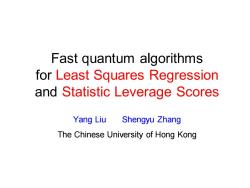
Fast quantum algorithms for Least Squares Regression and Statistic Leverage Scores Yang Liu Shengyu Zhang The Chinese University of Hong Kong
Yang Liu Shengyu Zhang The Chinese University of Hong Kong Fast quantum algorithms for Least Squares Regression and Statistic Leverage Scores

Part 1.Linear regression -Output a“quantum sketch”of solution. Part ll.Computing leverage scores and matrix coherence. Output the target numbers
• Part I. Linear regression – Output a “quantum sketch” of solution. • Part II. Computing leverage scores and matrix coherence. – Output the target numbers
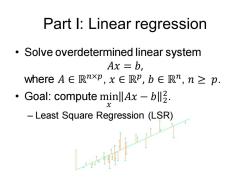
Part I:Linear regression Solve overdetermined linear system Ax =b, where A∈Rnxp,x∈RP,b∈Rn,n≥p. Goal:compute minllAx-bll. X Least Square Regression (LSR)
Part I: Linear regression • Solve overdetermined linear system 𝐴𝑥 = 𝑏, where 𝐴 ∈ ℝ𝑛×𝑝 , 𝑥 ∈ ℝ𝑝 , 𝑏 ∈ ℝ𝑛 , 𝑛 ≥ 𝑝. • Goal: compute min 𝑥 𝐴𝑥 − 𝑏 2 2 . – Least Square Regression (LSR)

Closed-form solution Closed-form solution known: x*=A+b=(AA)1AT, -A+:Moore-Penrose pseudo-inverse of A. If the SVD of A is Anxp UnxrDrxrVTxp where r rank(A),then A+VD-1UT. Classical complexity:0(n2p +np2) Prohibitively slow for big matrices A
Closed-form solution • Closed-form solution known: 𝑥 ∗ = 𝐴 +𝑏 = 𝐴 𝑇𝐴 −1𝐴 𝑇 , – 𝐴 +: Moore-Penrose pseudo-inverse of 𝐴. – If the SVD of 𝐴 is 𝐴𝑛×𝑝 = 𝑈𝑛×𝑟𝐷𝑟×𝑟𝑉𝑟×𝑝 𝑇 where 𝑟 = 𝑟𝑎𝑛𝑘(𝐴), then 𝐴 + = 𝑉𝐷 −1𝑈 𝑇 . • Classical complexity: 𝑂 𝑛 2𝑝 + 𝑛𝑝 2 • Prohibitively slow for big matrices 𝐴
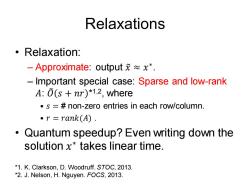
Relaxations 。Relaxation: -Approximate:outputx*. -Important special case:Sparse and low-rank A:0(s nr)*1,2,where .s =non-zero entries in each row/column. 。r=rank(A. Quantum speedup?Even writing down the solution x*takes linear time. *1.K.Clarkson,D.Woodruff.STOC,2013. *2.J.Nelson,H.Nguyen.FOCS,2013
Relaxations • Relaxation: – Approximate: output 𝑥 ≈ 𝑥 ∗ . – Important special case: Sparse and low-rank 𝐴: 𝑂෨ 𝑠 + 𝑛𝑟 * 1,2, where • 𝑠 = # non-zero entries in each row/column. • 𝑟 = 𝑟𝑎𝑛𝑘(𝐴) . • Quantum speedup? Even writing down the solution 𝑥 ∗ takes linear time. *1. K. Clarkson, D. Woodruff. STOC, 2013. *2. J. Nelson, H. Nguyen. FOCS, 2013
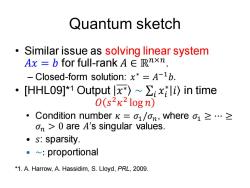
Quantum sketch Similar issue as solving linear system Ax b for full-rank A E Rxn. -Closed-form solution:x*=A-16. ·[HHL09]*1 Output x*)~∑ixli)in time 0(s2K2logn) ·Condition number x=o1/on,where o1≥·≥ on>0 are A's singular values. ·s:sparsity. 。~:proportional *1.A.Harrow,A.Hassidim,S.Lloyd,PRL,2009
Quantum sketch • Similar issue as solving linear system 𝐴𝑥 = 𝑏 for full-rank 𝐴 ∈ ℝ𝑛×𝑛 . – Closed-form solution: 𝑥 ∗ = 𝐴 −1𝑏. • [HHL09]*1 Output 𝑥 ∗ ∼ σ𝑖 𝑥𝑖 ∗ 𝑖 in time 𝑂 𝑠 2𝜅 2 log 𝑛 • Condition number 𝜅 = 𝜎1/𝜎𝑛, where 𝜎1 ≥ ⋯ ≥ 𝜎𝑛 > 0 are 𝐴’s singular values. • 𝑠: sparsity. • ∼: proportional *1. A. Harrow, A. Hassidim, S. Lloyd, PRL, 2009

Controversy Useless?Can't read out each solution variable x's. Useful?As intermediate steps,e.g.when some global info of x*is needed. -(c,x*)can be obtained from x*)by SWAP test. ·Classically also poly log n?Impossible unless P BOP
Controversy • Useless? Can’t read out each solution variable 𝑥𝑖 ∗ ’s. • Useful? As intermediate steps, e.g. when some global info of 𝑥 ∗ is needed. – 〈𝑐, 𝑥 ∗ 〉 can be obtained from 𝑥 ∗ by SWAP test. • Classically also 𝑝𝑜𝑙𝑦 log 𝑛? Impossible unless 𝐏 = 𝐁𝐐𝐏
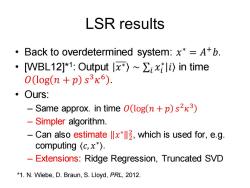
LSR results Back to overdetermined system:x*A+b. ·WBL12]*1:Output |x*)~Σix i)in time 0(1og(n+p)s3K6). 。OurS: Same approx.in time 0(log(n+p)s2K3) Simpler algorithm. Can also estimatex,which is used for,e.g. computing (c,x*). Extensions:Ridge Regression,Truncated SVD *1.N.Wiebe,D.Braun,S.Lloyd,PRL,2012
LSR results • Back to overdetermined system: 𝑥 ∗ = 𝐴 +𝑏. • [WBL12]*1 : Output 𝑥 ∗ ∼ σ𝑖 𝑥𝑖 ∗ 𝑖 in time 𝑂 log 𝑛 + 𝑝 𝑠 3𝜅 6 . • Ours: – Same approx. in time 𝑂 log 𝑛 + 𝑝 𝑠 2𝜅 3 – Simpler algorithm. – Can also estimate 𝑥 ∗ 2 2 , which is used for, e.g. computing 〈𝑐, 𝑥 ∗ 〉. – Extensions: Ridge Regression, Truncated SVD *1. N. Wiebe, D. Braun, S. Lloyd, PRL, 2012

Our algorithm for LSR 。Input:Hermition A∈Rnxn,b∈Rn.Assume A=2=1 vv:with1≥1之…之,≥ and the restλ;'sare0. Non-Hermition reduces to Hermition ·Output:Φ〉|)wWx≈x*,and≈lx*2: ·Note:Nrite b as b=iβ;lvi),then the desirable outputis
Our algorithm for LSR • Input: Hermition 𝐴 ∈ ℝ 𝑛×𝑛 , 𝑏 ∈ ℝ 𝑛 . Assume 𝐴 = σ𝑖=1 𝑛 𝜆𝑖 𝑣𝑖 𝑣𝑖 with 1 ≥ 𝜆1 ≥ ⋯ ≥ 𝜆𝑟 ≥ 1 𝜅 , and the rest 𝜆𝑖 ’s are 0. – Non-Hermition reduces to Hermition. • Output: 𝜙 ∼ |𝑥〉 w/ 𝑥 ≈ 𝑥 ∗ , and ℓ ≈ 𝑥 ∗ 2 2 . • Note: Write 𝑏 as 𝑏 = σ𝑖 𝛽𝑖 𝑣𝑖 , then the desirable output is 𝐴 +𝑏 = σ𝑖∈[𝑟] 𝛽𝑖 𝜆𝑖 𝑣𝑖
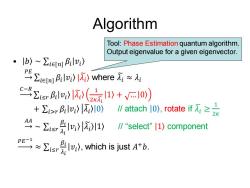
Algorithm Tool:Phase Estimation quantum algorithm. Output eigenvalue for a given eigenvector. ·Ib〉~∑nBil) PE Zein B:lv)lZi〉where元≈i c-xer1l0(2&I1)+VGI0) +∑i>rBlv)2I0〉》 ∥attach),rotate if元≥录 s~8r号m) /∥“select'"l1〉component PE,是IW.以wii*b
Algorithm • 𝑏 ∼ σ𝑖∈[𝑛] 𝛽𝑖 𝑣𝑖 𝑃𝐸 σ𝑖∈[𝑛] 𝛽𝑖 𝑣𝑖 |𝜆෩ 𝑖 〉 where 𝜆෩ 𝑖 ≈ 𝜆𝑖 𝐶−𝑅 σ𝑖≤𝑟 𝛽𝑖 𝑣𝑖 𝜆෩ 𝑖 1 2𝜅𝜆෩ 𝑖 1 + … 0 + σ𝑖>𝑟 𝛽𝑖 𝑣𝑖 𝜆෩ 𝑖 0 // attach 0 , rotate if 𝜆෩ 𝑖 ≥ 1 2𝜅 𝐴𝐴 ∼ σ𝑖≤𝑟 𝛽𝑖 𝜆𝑖 𝑣𝑖 𝜆෩ 𝑖 1 // “select” 1 component 𝑃𝐸 −1 ≈ σ𝑖≤𝑟 𝛽𝑖 𝜆𝑖 𝑣𝑖 , which is just 𝐴 +𝑏. Tool: Phase Estimation quantum algorithm. Output eigenvalue for a given eigenvector
按次数下载不扣除下载券;
注册用户24小时内重复下载只扣除一次;
顺序:VIP每日次数-->可用次数-->下载券;
- 香港中文大学:Sensitivity Conjecture and Log-rank Conjecture for functions with small alternating numbers.pptx
- 香港中文大学:Networked Fairness in Cake Cutting.pptx
- 《金陵科技学院学报》:高形变二维码识别算法设计与实现.pdf
- 东北大学:《可信计算基础》课程教学资源(试卷习题)期末考试样题.doc
- 东北大学:《可信计算基础》课程教学资源(PPT课件讲稿)TSS示例程序.pptx
- 东北大学:《可信计算基础》课程教学资源(PPT课件讲稿)TSS软件栈 TSS-TCG Software Stack.pptx
- 东北大学:《可信计算基础》课程教学资源(PPT课件讲稿)第6讲 可信启动.pptx
- 东北大学:《可信计算基础》课程教学资源(PPT课件讲稿)第6章 TPM核心功能.pptx
- 东北大学:《可信计算基础》课程教学资源(PPT课件讲稿)第6讲 可信计算基础.pptx
- 东北大学:《可信计算基础》课程教学资源(PPT课件讲稿)第4讲 公钥基础设施(PKI).ppt
- 东北大学:《可信计算基础》课程教学资源(PPT课件讲稿)第三讲 认证技术与数字签名.ppt
- 东北大学:《可信计算基础》课程教学资源(PPT课件讲稿)第二章 密码学技术.ppt
- 东北大学:《可信计算基础》课程教学资源(PPT课件讲稿)第一章 概述(主讲:周福才).pptx
- 东北大学:《信息安全专业概论与职业发展》课程教学资源(PPT课件讲稿)第一讲 浅析专业与兴趣(主讲:周福才).pptx
- 东北大学:《信息安全专业概论与职业发展》课程教学资源(PPT课件讲稿)第三讲 信息安全专业规范.pptx
- 东北大学:《信息安全专业概论与职业发展》课程教学资源(PPT课件讲稿)第二讲 信息安全概念、发展和现状.pptx
- 谷歌研究院(Google)数学之美与浪潮之巅.pdf
- 四川省普通高等学校专升本《大学计算机基础》考试大纲.pdf
- 华东理工学院:《数字图像处理 Digital Image Processing》课程教学资源(课件讲稿)第四章 灰度图像.pdf
- 华东理工学院:《数字图像处理 Digital Image Processing》课程教学资源(课件讲稿)第六章 分割.pdf
- 香港中文大学:Fourier sparsity, spectral norm, and the Log-rank conjecture(short).pptx
- 香港中文大学:Fourier sparsity, spectral norm, and the Log-rank conjecture(long).pptx
- 香港中文大学:Efficient protocols for generating bipartite classical distributions and quantum states.pptx
- 香港中文大学:On the complexity of trial and error.pptx
- 香港中文大学:A quantum protocol for sampling correlated equilibria unconditionally and without a mediator.pptx
- 香港中文大学:Quantum strategic game theory.ppt
- 香港中文大学:On the power of lower bound methods for quantum one-way communication complexity.ppt
- 香港中文大学:An Introduction to Quantum Computing in Theoretical Computer Science.ppt
- 香港中文大学:Random Walk on Graphs and its Algorithmic Applications.ppt
- 香港中文大学:《Probability and Statistics for Engineers》课程教学资源(课件讲稿)Sample space and probability.pdf
- 香港中文大学:《Probability and Statistics for Engineers》课程教学资源(课件讲稿)Sample space and probability.pptx
- 香港中文大学:《Probability and Statistics for Engineers》课程教学资源(课件讲稿)Discrete random variables.pdf
- 香港中文大学:《Probability and Statistics for Engineers》课程教学资源(课件讲稿)Discrete random variables.pptx
- 香港中文大学:《Probability and Statistics for Engineers》课程教学资源(课件讲稿)Further Topics on Random Variables.pdf
- 香港中文大学:《Probability and Statistics for Engineers》课程教学资源(课件讲稿)Further Topics on Random Variables.pptx
- 香港中文大学:《Probability and Statistics for Engineers》课程教学资源(课件讲稿)General random variables.pdf
- 香港中文大学:《Probability and Statistics for Engineers》课程教学资源(课件讲稿)Limit Theorems.pdf
- 香港中文大学:《Probability and Statistics for Engineers》课程教学资源(课件讲稿)Limit Theorems.pptx
- 香港中文大学:《Probability and Statistics for Engineers》课程教学资源(课件讲稿)Bayesian Statistical Inference.pdf
- 香港中文大学:《Probability and Statistics for Engineers》课程教学资源(课件讲稿)Bayesian Statistical Inference.pptx
